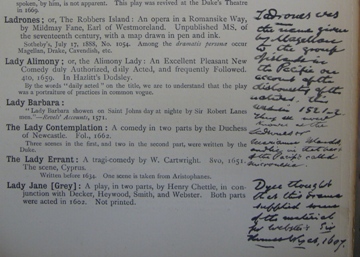Ladrones, or The Robbers' Island
Mildmay Fane, Earl of Westmoreland (1658)
Historical Records
Tom Cain notes that a manuscript entitled Ladrones or the Robbers’ Iland, an Opera in a Romansike Way was “lot 1,054 in the 1887 Sotheby’s sale” and that “[i]t was bought by Toovey for £3 3s, but has since vanished” (27). Harbage (PLMA 690) adds the specific date of the Sotheby's sale: 17 July 1888.
Theatrical Provenance
Unknown.
Probable Genre(s)
Foreign history, recent history, voyage drama.
Possible Narrative and Dramatic Sources or Analogues
 Detail of Hazlitt's marginalia, p127 Courtesy of the Folger Shakespeare Library |
Harbage notes that "Drake, Cavendish, and Magellan figure in the dramatis personae" (PMLA 690).
Hazlitt (127n, see image) notes in the marginal annotations of his personal copy of A manual for the collector and amateur of old English plays that:
Ladrones was the name given by Magellan to the group of islands in the Pacific on account of the dishonesty of the natives. This was in 1521-2. They are ever known as the Ladrones or Marianas Islands and lie in that part of the Pacific called Micronesia.
The story of Magellan's discovery and naming of the Ladrones is thus apparent; the experiences of Drake and Cavendish in this part of the Pacific are less clear. Francis Pretty's account in Hakluyt tells us that Cavendish's fleet arrived at the Ladrones on 03 January 1588, where they traded with the "60 or 70 sailes of canoas full of Sauages, who came off to sea vnto vs, and brought with them in their boates plantans, cocos, potato rootes, and fresh fish, which they had caught at sea, and helde them vp vnto vs for to truck or exchange with vs" (817). Pretty relates that when the Englishmen had concluded their trade with the natives, "yet we could not be rid of them. For afterward they were so thicke about the ship, that it stemmed & brake 1 or 2 of their canoas" (817). The English resort to firing their "harquebuzes" (arquebuses; a muzzle-loaded firearm) at the natives, but with no obvious effect (the natives dove into the water) (818).
References to the Play
Only the Sotheby's catalogue described by Cain and Harbage.
Critical Commentary
In the context of Davenant's hybrid entertainments of the Interregnum ("part debate, part opera, part masque, and part play" [Clare 832]) whose generic form was a necessity, because it “enabled them to circumvent the prohibition of 1642, subsequently reinforced, on the presentation of plays” (Clare 832), McInnis argues that "Mildmay Fane, Earl of Westmoreland, appears to have taken a similar approach with a lost entertainment of his own," noting that the full title Ladrones or the Robbers’ Iland, an Opera in a Romansike Way suggests its similar incorporation of music (186n).
For What It's Worth
The Mariana (Marianas) Islands in the Pacific were known as the Ladrones, from the Spanish Islas de los Ladrones, Islands of Thieves.
Hazlitt's printed entry for the play (p127) reads:
Ladrones; or, The Robbers Island: An opera in a Romansike Way, by Mildmay Fane, Earl of Westmoreland. Unpublished MS. of the seventeenth century, with a map drawn in pen and ink.
- Sotheby’s, July 17, 1888, No. 1054. Among the dramatis personæ occur Magellan, Drake, Cavendish, etc.
Works Cited
Site created and maintained by David McInnis, University of Melbourne; updated 19 March 2011.